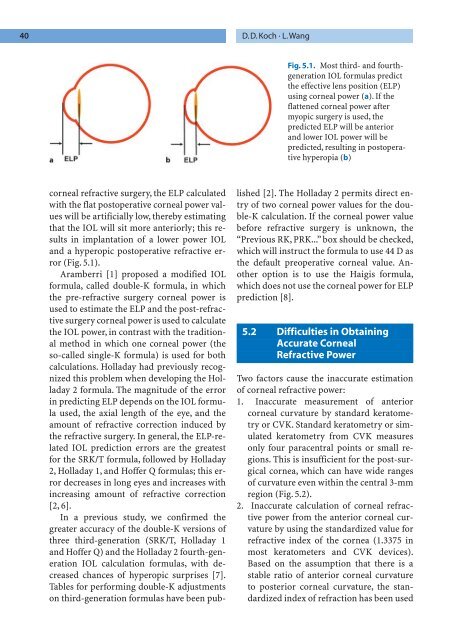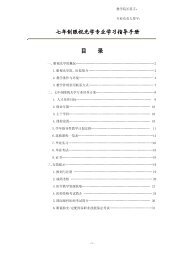Refractive Lens Surgery
Refractive Lens Surgery
Refractive Lens Surgery
You also want an ePaper? Increase the reach of your titles
YUMPU automatically turns print PDFs into web optimized ePapers that Google loves.
40 D.D. Koch · L.Wang<br />
corneal refractive surgery, the ELP calculated<br />
with the flat postoperative corneal power values<br />
will be artificially low, thereby estimating<br />
that the IOL will sit more anteriorly; this results<br />
in implantation of a lower power IOL<br />
and a hyperopic postoperative refractive error<br />
(Fig. 5.1).<br />
Aramberri [1] proposed a modified IOL<br />
formula, called double-K formula, in which<br />
the pre-refractive surgery corneal power is<br />
used to estimate the ELP and the post-refractive<br />
surgery corneal power is used to calculate<br />
the IOL power, in contrast with the traditional<br />
method in which one corneal power (the<br />
so-called single-K formula) is used for both<br />
calculations. Holladay had previously recognized<br />
this problem when developing the Holladay<br />
2 formula. The magnitude of the error<br />
in predicting ELP depends on the IOL formula<br />
used, the axial length of the eye, and the<br />
amount of refractive correction induced by<br />
the refractive surgery. In general, the ELP-related<br />
IOL prediction errors are the greatest<br />
for the SRK/T formula, followed by Holladay<br />
2, Holladay 1, and Hoffer Q formulas; this error<br />
decreases in long eyes and increases with<br />
increasing amount of refractive correction<br />
[2, 6].<br />
In a previous study, we confirmed the<br />
greater accuracy of the double-K versions of<br />
three third-generation (SRK/T, Holladay 1<br />
and Hoffer Q) and the Holladay 2 fourth-generation<br />
IOL calculation formulas, with decreased<br />
chances of hyperopic surprises [7].<br />
Tables for performing double-K adjustments<br />
on third-generation formulas have been pub-<br />
Fig. 5.1. Most third- and fourthgeneration<br />
IOL formulas predict<br />
the effective lens position (ELP)<br />
using corneal power (a). If the<br />
flattened corneal power after<br />
myopic surgery is used, the<br />
predicted ELP will be anterior<br />
and lower IOL power will be<br />
predicted, resulting in postoperative<br />
hyperopia (b)<br />
lished [2]. The Holladay 2 permits direct entry<br />
of two corneal power values for the double-K<br />
calculation. If the corneal power value<br />
before refractive surgery is unknown, the<br />
“Previous RK, PRK...” box should be checked,<br />
which will instruct the formula to use 44 D as<br />
the default preoperative corneal value. Another<br />
option is to use the Haigis formula,<br />
which does not use the corneal power for ELP<br />
prediction [8].<br />
5.2 Difficulties in Obtaining<br />
Accurate Corneal<br />
<strong>Refractive</strong> Power<br />
Two factors cause the inaccurate estimation<br />
of corneal refractive power:<br />
1. Inaccurate measurement of anterior<br />
corneal curvature by standard keratometry<br />
or CVK. Standard keratometry or simulated<br />
keratometry from CVK measures<br />
only four paracentral points or small regions.<br />
This is insufficient for the post-surgical<br />
cornea, which can have wide ranges<br />
of curvature even within the central 3-mm<br />
region (Fig. 5.2).<br />
2. Inaccurate calculation of corneal refractive<br />
power from the anterior corneal curvature<br />
by using the standardized value for<br />
refractive index of the cornea (1.3375 in<br />
most keratometers and CVK devices).<br />
Based on the assumption that there is a<br />
stable ratio of anterior corneal curvature<br />
to posterior corneal curvature, the standardized<br />
index of refraction has been used



